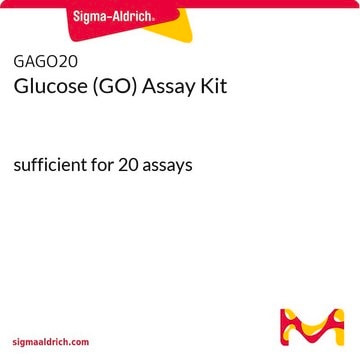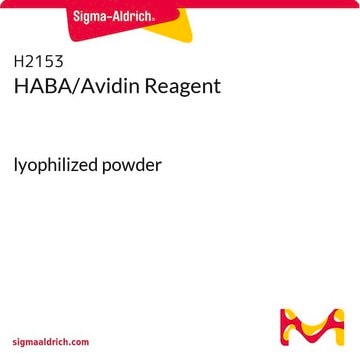Products may be shipped at a different temperature than the recommended long-term storage temperature. If the product quality is sensitive to short-term exposure to conditions other than the recommended long-term storage, it will be shipped on wet or dry-ice. If the product quality is NOT affected by short-term exposure to conditions other than the recommended long-term storage, it will be shipped at ambient temperature. As shipping routes are configured for minimum transit times, shipping at ambient temperature helps control shipping costs for our customers. For more information, please refer to the Storage and Transport Conditions document: https://www.sigmaaldrich.com/deepweb/assets/sigmaaldrich/marketing/global/documents/316/622/storage-transport-conditions-mk.pdf
MAK171
Colorimetric Biotin Assay Kit
sufficient for 200 colorimetric assays
Synonyme(s) :
Biotin Quantitation Kit
Sélectionner une taille de conditionnement
Sélectionner une taille de conditionnement
About This Item
Produits recommandés
Méthode de détection
colorimetric
Maladie(s) pertinente(s)
dermatological diseases; neurological disorders
Conditions d'expédition
dry ice
Température de stockage
−20°C
Catégories apparentées
Description générale
Adéquation
Principe
Notes préparatoires
Precautions and Disclaimer: This product is for R&D;use only, not for drug, household, or other uses. Please consult the Safety Data Sheet for information regarding hazards and safe handling practices.
Code de la classe de stockage
10 - Combustible liquids
Faites votre choix parmi les versions les plus récentes :
Déjà en possession de ce produit ?
Retrouvez la documentation relative aux produits que vous avez récemment achetés dans la Bibliothèque de documents.
Les clients ont également consulté
-
How is shipping temperature determined? And how is it related to the product storage temperature?
1 réponse-
Utile ?
-
-
How can I determine the shelf life / expiration / retest date of this product?
1 réponse-
If this product has an expiration or retest date, it will be shown on the Certificate of Analysis (COA, CofA). If there is no retest or expiration date listed on the product's COA, we do not have suitable stability data to determine a shelf life. For these products, the only date on the COA will be the release date; a retest, expiration, or use-by-date will not be displayed.
For all products, we recommend handling per defined conditions as printed in our product literature and website product descriptions. We recommend that products should be routinely inspected by customers to ensure they perform as expected.
For products without retest or expiration dates, our standard warranty of 1 year from the date of shipment is applicable.
For more information, please refer to the Product Dating Information document: https://www.sigmaaldrich.com/deepweb/assets/sigmaaldrich/marketing/global/documents/449/386/product-dating-information-mk.pdfUtile ?
-
-
What are the instructions for running the kit with catalog number MAK171? Additionally, needs more information to understand the purpose of this kit and how to perform calculations if purchased.
1 réponse-
The Colorimetric Biotin Quantitation Kit with catalog number MAK171 offers a convenient method for estimating the molar ratio of biotin to protein in biotin-protein conjugates or for quantifying biotin concentration in a solution. The assay utilizes HABA [2-(4-Hydroxyphenylazo)benzoic acid], a reagent that exhibits significant spectral changes when bound to avidin. Biotin readily displaces HABA from the HABA/Avidin complex, leading to a decrease in absorption at 500 nm. The kit provides an optimal ratio of Avidin and HABA and is most effective for determining biotin concentration in the range from 2–16 mM. The assay can be carried out in a cuvette or microplate format.
Utile ?
-
-
Is it possible to use RIPA buffer as the lysis reagent with the Colorimetric Biotin Assay Kit, product number MAK171-1KT, to extract proteins and biotin from samples such as brain parenchymal tissues?
1 réponse-
RIPA buffer as the lysis reagent is acceptable, provided that the concentration of the RIPA buffer is consistent with that of the control.
Utile ?
-
-
Pourquoi la concentration du control positif n'est pas donnée ? Question de savoir si le test a bien fonctionné et la concentration de notre échantillon est juste.
1 réponse-
The positive control is a vial of 100uL of 100uM d-biotin.
Utile ?
-
-
Can I use it to measure serum samples?
1 réponse-
This product is suitable for biotin-containing samples. The range of detection for this kit is 2 - 16 uM. Biotin concentrations would need to be within this range. Please see the link below to review the product datasheet for this kit:
https://www.sigmaaldrich.com/deepweb/assets/sigmaaldrich/product/documents/116/046/mak171bul.pdfUtile ?
-
Filtres actifs
Notre équipe de scientifiques dispose d'une expérience dans tous les secteurs de la recherche, notamment en sciences de la vie, science des matériaux, synthèse chimique, chromatographie, analyse et dans de nombreux autres domaines..
Contacter notre Service technique








